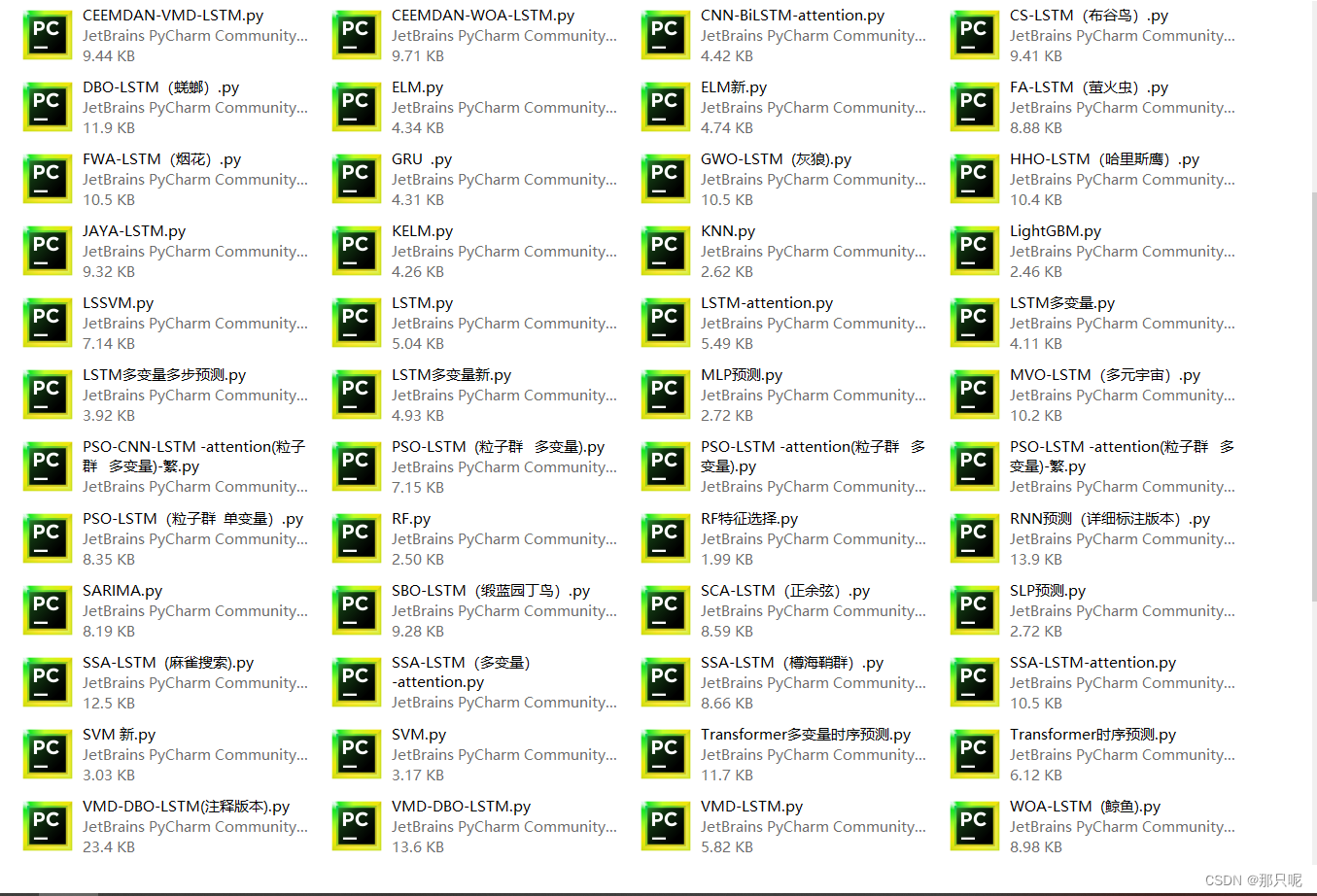整理了基于SARIMA的时间序列预测模型python代码,免费分享给大家,记得点赞哦!
#!/usr/bin/env python
# coding: utf-8
# # 导入环境中的相关包
import itertools
import numpy as np #
import pandas as pd #
import matplotlib.pyplot as plt
from matplotlib.ticker import MultipleLocator
import warnings
from statsmodels.graphics.tsaplots import plot_acf, plot_pacf
from statsmodels.stats.diagnostic import acorr_ljungbox
from statsmodels.tsa.statespace.sarimax import SARIMAX
from sklearn.metrics import r2_score,mean_absolute_error,mean_squared_error
from statsmodels.tsa.stattools import adfuller
import math
import seaborn as sns
import statsmodels.api as sm
import tensorflow as tf
from pmdarima import auto_arima
#显示中文
#忽略警告
warnings.filterwarnings('ignore')
plt.rcParams['font.sans-serif']=['SimHei'] #用来正常显示中文标签
plt.rcParams['figure.figsize'] = (10.0, 8.0) # set default size of plots
plt.rcParams['image.interpolation'] = 'nearest'
plt.rcParams['image.cmap'] = 'gray'
# 调用GPU加速
gpus = tf.config.experimental.list_physical_devices(device_type='GPU')
for gpu in gpus:
tf.config.experimental.set_memory_growth(gpu, True)
df = pd.read_csv("shao - 单.csv",usecols=[1]) #读取数据
df.head()
plt.figure(figsize=(15, 3))
plt.title('风速')
plt.xlabel('时间')
plt.ylabel('最大风速')
plt.plot(df, 'b', label='AQI')
plt.legend()
plt.show()
#定义稳定性检验函数
def adf_val(ts, ts_title):
adf, pvalue, usedlag, nobs, critical_values, icbest = adfuller(ts)
name = ['adf', 'pvalue', 'usedlag',
'nobs', 'critical_values', 'icbest']
values = [adf, pvalue, usedlag, nobs,
critical_values, icbest]
print(list(zip(name, values)))
return adf, pvalue, critical_values,
# 返回adf值、adf的p值、三种状态的检验值
#白噪声检验也称为纯随机性检验,当数据是纯随机数据时,再对数据进行分析就没有任何意义了,所以拿到数据后最好对数据进行一个纯随机性检验。
def acorr_val(ts):
'''
# 白噪声(随机性)检验
ts: 时间序列数据,Series类型
返回白噪声检验的P值
'''
lbvalue, pvalue = acorr_ljungbox(ts, lags=1) # 白噪声检验结果
return lbvalue, pvalue
def tsplot(y, lags=None, figsize=(14, 8)):
fig = plt.figure(figsize=figsize)
layout = (2, 2)
ts_ax = plt.subplot2grid(layout, (0, 0))
hist_ax = plt.subplot2grid(layout, (0, 1))
acf_ax = plt.subplot2grid(layout, (1, 0))
pacf_ax = plt.subplot2grid(layout, (1, 1))
y.plot(ax=ts_ax)
ts_ax.set_title('A Given Training Series')
y.plot(ax=hist_ax, kind='hist', bins=25)
hist_ax.set_title('Histogram')
#自相关(Autocorrelation): 对一个时间序列,现在值与其过去值的相关性。如果相关性为正,则说明现有趋势将继续保持。
plot_acf(y, lags=lags, ax=acf_ax)
#可以度量现在值与过去值更纯正的相关性
plot_pacf(y, lags=lags, ax=pacf_ax)
[ax.set_xlim(0) for ax in [acf_ax, pacf_ax]]
sns.despine()
fig.tight_layout()
fig.show()
return ts_ax, acf_ax, pacf_ax
ts_data = df.astype('float32')
#adf结果为-10.4, 小于三个level的统计值。pvalue也是接近于0 的,所以是平稳的
adf, pvalue1, critical_values = adf_val(ts_data, 'raw time series')
print('adf',adf)
print('pvalue1',pvalue1)
print('critical_values',critical_values)
#若p值远小于0.01,认为该时间序列是平稳的
aco=acorr_val(ts_data)
print('aco',aco)
##自相关和偏自相关
tsplot(ts_data, lags=20)
train_data, test_data = df[0:int(len(df)*0.8)], df[int(len(df)*0.8):]
#画出训练集和测试集的原数据(open 价格)
plt.figure(dpi=100, figsize=(20,5))
plt.title('Air Quality Index of Nanning City', size=40)
plt.xlabel('time/day',size=30)
plt.ylabel('AQI',size=30)
plt.plot(train_data, 'b', label='Training Data',linewidth=3)
plt.plot(test_data, 'g', label='Testing Data',linewidth=3)
font = {'serif': 'Times New Roman','size': 30}
plt.rc('font', **font)
plt.legend()
plt.show()
#取划分的数据
train_ar = train_data.values
test_ar = test_data.values
auto_arima(train_data, seasonal=True, m=12,max_p=7, max_d=2,max_q=7, max_P=4, max_D=4,max_Q=4).summary()
def best_sarima_model(train_data,p,q,P,Q,d=1,D=1,s=12):
best_model_aic = np.Inf
best_model_bic = np.Inf
best_model_hqic = np.Inf
best_model_order = (0,0,0)
models = []
for p_ in p:
for q_ in q:
for P_ in P:
for Q_ in Q:
try:
no_of_lower_metrics = 0
model = SARIMAX(endog=train_data,order=(p_,d,q_), seasonal_order=(P_,D,Q_,s),
enforce_invertibility=False).fit()
models.append(model)
if model.aic <= best_model_aic: no_of_lower_metrics+=1
if model.bic <= best_model_bic: no_of_lower_metrics+=1
if model.hqic <= best_model_hqic:no_of_lower_metrics+=1
if no_of_lower_metrics >= 2:
best_model_aic = np.round(model.aic,0)
best_model_bic = np.round(model.bic,0)
best_model_hqic = np.round(model.hqic,0)
best_model_order = (p_,d,q_,P_,D,Q_,s)
current_best_model = model
models.append(model)
print("Best model: SARIMA" + str(best_model_order) +
" AIC:{} BIC:{} HQIC:{}".format(best_model_aic,best_model_bic,best_model_hqic)+
" resid:{}".format(np.round(np.exp(current_best_model.resid).mean(),3)))
except:
pass
print('\n')
print(current_best_model.summary())
return current_best_model, models
best_model, models = best_sarima_model(train_data=train_ar,p=range(3),q=range(3),P=range(3),Q=range(3))
p = range(0, 3)
d = range(0, 1)
q = range(0, 3)
pdq = list(itertools.product(p, d, q))
seasonal_pdq = [(x[0], x[1], x[2], 6) for x in list(itertools.product(p, d, q))]
min_aic = 999999999
for param in pdq:
for param_seasonal in seasonal_pdq:
try:
mod = sm.tsa.statespace.SARIMAX(train_ar,
order=param,
seasonal_order=param_seasonal,
enforce_stationarity=False,
enforce_invertibility=False)
results = mod.fit()
print('ARIMA{}x{}12 - AIC:{}'.format(param, param_seasonal, results.aic))
if results.aic < min_aic:
min_aic = results.aic
min_aic_model = results
except:
continue
min_aic_model.summary()
# # 构建训练数据
history = [x for x in train_ar]
print(type(history))
predictions = list()
#训练ARIMA模型
for t in range(len(test_ar)):
model = sm.tsa.SARIMAX(history,order=(2,1,1), seasonal_order=(0,0,1,12),enforce_invertibility=False)
model_fit = model.fit()
output = model_fit.forecast()#模型预测
yhat = output[0]
predictions.append(yhat)
obs = test_ar[t]
history.append(obs)
print('predicted=%f, expected=%f' % (yhat, obs))
testScore = math.sqrt(mean_squared_error(test_ar, predictions))
print('RMSE %.3f ' %(testScore))
testScore = r2_score(test_ar, predictions)
print('R2 %.3f' %(testScore))
testScore = mean_absolute_error(test_ar, predictions)
print('MAE %.3f ' %(testScore))
#只显示预测部分,不显示训练数据部分
plt.figure(figsize=(12,7))
plt.plot(test_data.index, predictions, color='b', marker='o', linestyle='dashed',label='Predicted')
plt.plot(test_data.index, test_data, color='red', label='Actual')
plt.title('SARIMA')
plt.xlabel('time')
plt.ylabel('AQI')
plt.legend()
plt.show()
更多时间序列预测代码:时间序列预测算法全集合--深度学习























 430
430











 被折叠的 条评论
为什么被折叠?
被折叠的 条评论
为什么被折叠?








